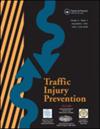量化驾驶中的感知风险:蒙地卡罗避障方法。
IF 1.9
3区 工程技术
Q3 PUBLIC, ENVIRONMENTAL & OCCUPATIONAL HEALTH
引用次数: 0
摘要
研究目的本研究旨在建立一个量化避障过程中感知风险的模型,强调驾驶者感知的风险特征如何影响其驾驶决策。该研究从驾驶员风险感知的角度出发,解决了风险建模缺乏关注的问题:方法:采用蒙特卡罗方法来考虑驾驶行为的不确定性和复杂性,还原风险的概率性质。所提出的方法通过纳入驾驶员的模糊感知来量化感知风险,从而在避障过程中进行量化评估。使用 logit 模型将感知风险与驾驶决策联系起来,从而确定影响驾驶员在避障场景中行为的关键因素:实验数据显示,由于驾驶员的经验和熟练程度不同,车辆的行驶轨迹和速度分布存在很大差异。与右侧绕行相比,左侧绕行的感知风险指标(PRI)值更高,接收器操作特征曲线(ROC)证实了 PRI 的强大预测能力,曲线下面积(AUC)为 0.820。Logit 模型显示,PRI 和速度对选择向右绕行的概率有显著影响,准确率达到 90%。在该模型的基础上,研究预测了在距离障碍物 200 米范围内,不同位置和速度的车辆为避开障碍物而右转的概率,并将其可视化:这项研究为交通专业人员了解驾驶员感知风险和决策机制提供了一个框架。这种理解有利于改善交通安全,并强调了在驾驶行为建模中考虑驾驶员风险感知的重要性。本文章由计算机程序翻译,如有差异,请以英文原文为准。
Quantifying perceived risk in driving: A Monte Carlo approach for obstacle avoidance
Objective
This study aims to develop a model for quantifying perceived risk in obstacle avoidance, emphasizing how drivers’ perceived risk characteristics influence their driving decisions. The research addresses the lack of attention given to modeling risk from the perspective of drivers’ risk perceptions.
Methods
Monte Carlo methods are employed to account for the uncertainties and complexities of driving behavior, restoring the probabilistic nature of risk. The proposed method quantifies perceived risk by incorporating drivers’ fuzzy perceptions, enabling a quantitative evaluation during obstacle avoidance. A logit model is used to link perceived risk with driving decisions, identifying key factors influencing driver behavior in obstacle avoidance scenarios.
Results
Experimental data revealed significant variations in vehicle trajectories and speed distributions due to differences in drivers’ experience and proficiency. The perceived risk indicator (PRI) values for leftward bypasses were higher compared to rightward bypasses, and the receiver operating characteristic (ROC) curve confirmed the PRI’s strong predictive ability with an area under the curve (AUC) of 0.820. The logit model showed that both PRI and speed significantly influenced the probability of choosing a rightward bypass, achieving 90% accuracy. Building on the model, the study predicted and visualized the probability of vehicles turning right to avoid obstacles at different positions and speeds within 200 m of the obstacle.
Conclusions
The research offers a framework for traffic professionals to understand driver-perceived risk and decision-making mechanisms. This understanding is beneficial for improving traffic safety and highlights the importance of considering drivers’ risk perceptions in modeling driving behavior.
求助全文
通过发布文献求助,成功后即可免费获取论文全文。
去求助
来源期刊

Traffic Injury Prevention
PUBLIC, ENVIRONMENTAL & OCCUPATIONAL HEALTH-
CiteScore
3.60
自引率
10.00%
发文量
137
审稿时长
3 months
期刊介绍:
The purpose of Traffic Injury Prevention is to bridge the disciplines of medicine, engineering, public health and traffic safety in order to foster the science of traffic injury prevention. The archival journal focuses on research, interventions and evaluations within the areas of traffic safety, crash causation, injury prevention and treatment.
General topics within the journal''s scope are driver behavior, road infrastructure, emerging crash avoidance technologies, crash and injury epidemiology, alcohol and drugs, impact injury biomechanics, vehicle crashworthiness, occupant restraints, pedestrian safety, evaluation of interventions, economic consequences and emergency and clinical care with specific application to traffic injury prevention. The journal includes full length papers, review articles, case studies, brief technical notes and commentaries.
 求助内容:
求助内容: 应助结果提醒方式:
应助结果提醒方式:


